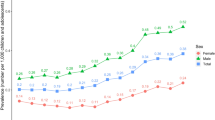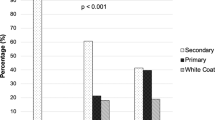Abstract
The knowledge of epidemiology of a disease is paramount in identifying preventive measures. Currently there is a paucity of literature on the epidemiologic determinants of childhood onset essential hypertension (EH). We evaluated children with EH, ascertained in a rigorous manner, in a large multiethnic population in a tertiary pediatric hypertension clinic. We enrolled children with and without EH and obtained data by in-person interview of their parents and by direct anthropometric measurements including blood pressures. A total of 148 children (76 hypertension probands, 72 control probands, and males 53%, mean age 12.2 ± 4.3 years) were enrolled. Of these 148 children, 51 pairs were matched 1:1 on ethnicity, gender and age (±2.5 years). In this study we evaluated the demographics, genetic predisposition and a variety of exposures including, socioeconomic, perinatal, lifestyle and environmental, between cases and controls. All measures were similar between cases and controls other than a significantly higher BMI (p = 0.01) and rates of obesity (p = 0.03), and a difference of near-significance in any family history of EH (p = 0.05) higher in cases compared to controls. The odds of obesity was 3.5 times higher among cases than controls. In this study, we evaluated a variety of prenatal and postnatal exposures that could potentially contributed to the EH phenotype in childhood. The findings of the study elucidate the epidemiology of EH in children and two important associated risk factors, any family history of hypertension and a higher body weight.
This is a preview of subscription content, access via your institution
Access options
Subscribe to this journal
Receive 12 digital issues and online access to articles
$119.00 per year
only $9.92 per issue
Buy this article
- Purchase on Springer Link
- Instant access to full article PDF
Prices may be subject to local taxes which are calculated during checkout
Similar content being viewed by others
References
National High Blood Pressure Education Program Working Group on High Blood Pressure in C, Adolescents. The fourth report on the diagnosis, evaluation, and treatment of high blood pressure in children and adolescents. Pediatrics. 2004;114(2 Suppl):555–76.
Brady TM, Neu AM, Miller ER 3rd, Appel LJ, Siberry GK, Solomon BS. Real-time electronic medical record alerts increase high blood pressure recognition in children. Clin Pediatr. 2015;54:667–75.
Banker A, Bell C, Gupta-Malhotra M, Samuels J. Blood pressure percentile charts to identify high or low blood pressure in children. BMC Pediatr. 2016;16:98.
Koebnick C, Black MH, Wu J, Martinez MP, Smith N, Kuizon BD, et al. The prevalence of primary pediatric prehypertension and hypertension in a real-world managed care system. J Clin Hypertens. 2013;15:784–92.
Sharma PK, Ahuja V, Madan K, Gupta S, Raizada A, Sharma MP. Prevalence, severity, and risk factors of symptomatic gastroesophageal reflux disease among employees of a large hospital in northern India. Indian J Gastroenterol. 2011;30:128–34.
Flynn JT, Alderman MH. Characteristics of children with primary hypertension seen at a referral center. Pediatr Nephrol. 2005;20:961–6.
Brady TM, Fivush B, Parekh RS, Flynn JT. Racial differences among children with primary hypertension. Pediatrics. 2010;126:931–7.
Gupta-Malhotra M, Banker A, Shete S, Hashmi SS, Tyson JE, Barratt MS, et al. Essential hypertension vs. secondary hypertension among children. Am J Hypertens. 2015;28:73–80.
Gupta-Malhotra M, Hashmi SS, Poffenbarger T, McNiece-Redwine K. Left ventricular hypertrophy phenotype in childhood-onset essential hypertension. J Clin Hypertens. 2016;18:449–55.
McNiece KL, Gupta-Malhotra M, Samuels J, Bell C, Garcia K, Poffenbarger T, et al. Left ventricular hypertrophy in hypertensive adolescents: analysis of risk by 2004 National High Blood Pressure Education Program Working Group staging criteria. Hypertension. 2007;50:392–5.
Gupta-Malhotra M, Hamzeh RK, Poffenbarger T, McNiece-Redwine K, Hashmi SS. Myocardial Performance Index in childhood onset essential hypertension and white coat hypertension. Am J Hypertens. 2016;29:379–87.
Agu NC, McNiece Redwine K, Bell C, Garcia KM, Martin DS, Poffenbarger TS, et al. Detection of early diastolic alterations by tissue Doppler imaging in untreated childhood-onset essential hypertension. J Am Soc Hypertens. 2014;8:303–11.
Gupta-Malhotra M, Devereux RB, Dave A, Bell C, Portman R, Milewicz D. Aortic dilatation in children with systemic hypertension. J Am Soc Hypertens. 2014;8:239–45.
Crowley MJ, Grubber JM, Olsen MK, Bosworth HB. Factors associated with non-adherence to three hypertension self-management behaviors: preliminary data for a new instrument. J Gen Intern Med. 2013;28:99–106.
Urbina E, Alpert B, Flynn J, Hayman L, Harshfield GA, Jacobson M, et al. Ambulatory blood pressure monitoring in children and adolescents: recommendations for standard assessment: a scientific statement from the American Heart Association Atherosclerosis, Hypertension, and Obesity in Youth Committee of the council on cardiovascular disease in the young and the council for high blood pressure research. Hypertension. 2008;52:433–51.
Barlow SE, Expert C. Expert committee recommendations regarding the prevention, assessment, and treatment of child and adolescent overweight and obesity: summary report. Pediatrics. 2007;120(Suppl 4):S164–92.
Diabetes A. 12. Children and adolescents: standards of medical care in diabetes-2018. Diabetes Care. 2018;41(Suppl 1):S126–36.
Gupta-Malhotra M, Hashmi SS, Barratt MS, Milewicz DM, Shete S. Familial aggregation of first degree relatives of children with essential hypertension. Blood Press. 2018;1–8.
Baracco R, Kapur G, Mattoo T, Jain A, Valentini R, Ahmed M, et al. Prediction of primary vs secondary hypertension in children. J Clin Hypertens (Greenwich). 2012;14:316–21.
Robinson RF, Batisky DL, Hayes JR, Nahata MC, Mahan JD. Body mass index in primary and secondary pediatric hypertension. Pediatr Nephrol. 2004;19:1379–84.
Sorof JM, Poffenbarger T, Franco K, Bernard L, Portman RJ. Isolated systolic hypertension, obesity, and hyperkinetic hemodynamic states in children. J Pediatr. 2002;140:660–6.
Parker ED, Sinaiko AR, Kharbanda EO, Margolis KL, Daley MF, Trower NK, et al. Change in weight status and development of hypertension. Pediatrics. 2016;137:e20151662.
Gupta-Malhotra M, Hashmi SS, Barratt MS, Milewicz DM, Shete S. Childhood-onset essential hypertension and the family structure. J Clin Hypertens. 2016;18:431–8.
Acknowledgements
We would like to thank Dr. Sanjay Shete, Dr. Michelle S. Barratt, Dr. Dianna Milewicz, Dr. Jon Tyson, Dr. Eric Boerwinkle and Dr. Jacqueline Hecht for mentorship of MG-M during her career development award by the National Institutes of Health. We would also like to thank the families who agreed to participate in this study.
Funding:
The project described was supported by Grant Number K23HL089391 for “Determination of genetics of childhood onset hypertension” (PI Monesha Gupta) from the National Heart, Lung, and Blood Institute. The content is solely the responsibility of the authors and does not necessarily represent the official views of the National Heart, Lung, and Blood Institute or the National Institutes of Health.
Author information
Authors and Affiliations
Corresponding author
Ethics declarations
Conflict of interest
The authors declare that they have no conflict of interest.
Electronic supplementary material
Rights and permissions
About this article
Cite this article
Gupta-Malhotra, M., Shete, S., Barratt, M.S. et al. Epidemiology of Childhood Onset Essential Hypertension. J Hum Hypertens 32, 808–813 (2018). https://doi.org/10.1038/s41371-018-0110-x
Received:
Revised:
Accepted:
Published:
Issue Date:
DOI: https://doi.org/10.1038/s41371-018-0110-x
This article is cited by
-
Physical activity and eating behaviors patterns associated with high blood pressure among Chinese children and adolescents
BMC Public Health (2023)
-
Family history of arterial hypertension and central adiposity: impact on blood pressure in schoolchildren
BMC Pediatrics (2022)
-
Implications of the 2017 AAP Clinical Practice Guidelines for Management of Hypertension in Children and Adolescents: a Review
Current Hypertension Reports (2019)



